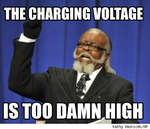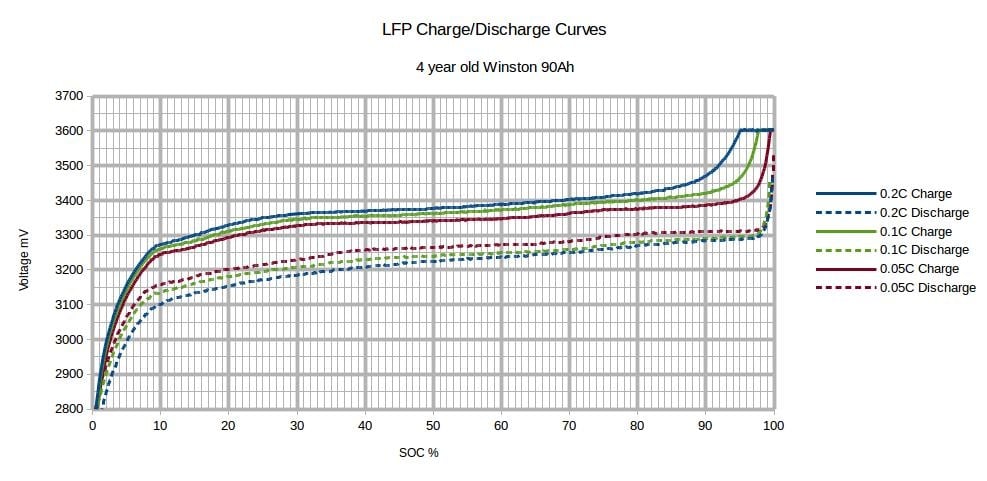User Tools
Table of Contents
DRAFT
Problems caused by lithium charging profiles
You'd think that a “lithium profile” would be suitable for lithium. That may or may not be so for your particular use case. Read on…
excessive charging voltage
So your LiFePO4 battery is acting up:
- won't charge fully
- seems to have reduced capacity
- voltages in the system are spiking, perhaps tripping your inverter
It's fairly common for excessive charging voltage to indirectly cause these symptoms. Unfortunately it's very common for preconfigured Lithium profiles to charge at voltages high enough to start the problematic chain of events.
TLDR
If excessive charging voltage is the problem then reducing the charging voltage will cause the symptoms to improve or disappear.
the full process
- reduce charging voltage (aka “absorption voltage”, “boost voltage”) to something like 13.6v. Float if used, can be set to something like 13.3v-13.4v. You may have to use a USER profile instead of a canned LITHIUM profile to make these changes.1) If you choose to modify the Li profile itself take a pic or notes of the original settings so you know what they were and can return to them later if desired.2)
- observe for a few days. Charging will be slower and may not finish by sundown3); we want to see if it can keep on charging rather than trigger BMS cutoff.
- if symptoms do clear up you can start to raise the charging voltage back up gradually (13.65v, 13.7v, 13.75v, etc) or you can leave it low if you are getting enough charge. {note from secessus: there is little benefit to charging LiFePO4 >13.8v.] Float can remain low at 13.3v-13.4v.
- if it starts acting up again drop charging voltage back down a notch or two
why lower-voltage charging works
LiFePO4 will fully charge at voltages as low as the mid-13s, but it will take more time. That extra time is called “Absorption duration”4). At the kinds of current levels we usually see in offgrid charging5) the duration looks like this:
- ≥14.0v will charge to ~100% SoC with zero minutes of absorption durations: hit the voltage setpoint and stop. Cell voltages tend to diverge as charging voltage increases above 14.0v because they are further up the knee (see below)
- 13.8v will charge to ~100% SoC with a small amount of Absorption (10-30 minutes?) and cells tend to stay in balance.
- 13.6v will charge to ~100% SoC with several hours of Absorption (example with data) ←- where we are starting
why the problem occurs
- lithium cell voltages are very “flat” for most of their usable capacity. When deeply discharged the voltage drops off dramatically, and when they are overcharged their voltage spikes dramatically. Because of the shape of this voltage curve we sometimes say there is a “lower knee”, broad flat middle, and “upper knee”.
- when one cell hits the knee first it can “run away” voltage-wise, and do so quite suddenly. This unevenness in cell voltage is called “imbalance” and is more likely to happen with higher charging voltages.6)
- the BMS sees the runaway and shuts down charging to avoid damaging the cell7)
- which stops all charging of the battery8)
- if the cell imbalance is bad enough the battery can't charge anywhere near full because the misbehaving cell is causing charging to shut down early.
So we ease up on charging which encourages the cell to stay in line with the others, which allows for a full battery charge.
The bigger question is this: why do battery and charger manufacturers specify such high charging voltages in the first place? It's not a plot; there really are some benefits to charging at higher voltages, especially when selling to the general public.
further reading
lack of pseudo-float
So your charge controller isn't charging even though battery state of charge is dropping?
This can be intentional behavior, caused by a Li profile that
- charges to a high voltage (see above)
- then allows the battery to discharge until it hits the Rebulk setpoint…
- at which point it charges to the high voltage again…
- rinse and repeat until the sun goes down
During the discharge stage the controller will appear to stop working. In reality it's waiting to hit that rebulk setpoint to start the party again.
To avoid this problem. configure a “float” voltage of 13.3v-13.4v. This will hold state of charge without overcharging.



